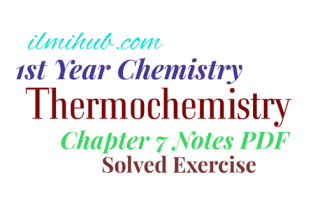In this post, I am sharing the 1st Year Chemistry Chapter 6 Solved Exercise Notes PDF for the students of FSC Part 1. I will share this chapter in 4 parts, Long Questions, Short Questions, Additional MCQs & Solved Exercise Notes. Students can download all other 3 parts of 11th Chemistry Chapter 6 Chemical Bonding Solved Exercise Notes PDF. 11th Chemistry all Chapters Notes are also available at ilmihub.
1st Year Chemistry Chapter 6 Chemical Bonding Solved Exercise Notes PDF Download
Solved Questions from FSC Part 1 Chemistry Chapter 6 Exercise
Q.1 Select the correct statement.
(i) An ionic compund A+B– is most likely to be formed when
(a) the ionization energy of A is high and electron affinity of B is low.
(b) the ionization energy of A is low and electron affinity of B is high.
(c) both the ionization energy of A and electron affinity of B are high.
(d) both the ionization energy of A and electron affinity of B are low.
(ii) The number of bounds in nitrogen molecule is?
(a) one σ and one π
(b) one σ and two π
(c) three sigma only
(d) two σ and one π
(iii) Which of the following statements is not correct regarding bonding molecular orbitals?
(a) Bonding molecular orbitals possess less energy than atomic orbitals from which they are formed.
(b) Bonding molecular orbitals have low electron density between two nuclei.
(c) Every electron in the bonding molecular orbitals contributes to the attraction between atoms.
(d) Bonding molecular orbitals are formed when the electron waves undergo constructive interference.
(iv) Which of the following molecules has zero dipole moment?
(a) NH3
(b) CHCl3
(c) H2O
(d) BF3
(v) Which of the hydrogen halides has the highest percentage of ionic character?
(a) HCl
(b) HBr
(c) HF
(d) HI
Q.2 Fill in the Blanks
(i) The tendency of atoms to attain maximum of________ electrons in the valence shell is called completion of octet. (Answer = Eight)
(ii) The geometrical shape of SiCl4 and PCl3 can be explained on the basis of______ and_______ hybridizations. (Answer = sp3 , sp3)
(iii) The VSEPR theory stands for . (Answer = Valence shell electron pair repulsion theory)
(iv) For N2 molecule, the energy of σ (2Px) orbital is ________ than π (2Py) orbital. (Answer = Higher)
(v) The paramagnetic property of O2 is well explained on the basis of MO theory in terms of the presence of __________ electrons in two MO orbitals. (Answer = Unpaired)
Q.3 Classify the Statements as true or false.
(i) the core of an atom is the atom minus its valence shell. (True)
(ii) The molecules of nitrogen (N=N) and acetylene (HC=CH) are not isolelectronic. (False)
(iii) There are four coordinate covalent bonds in NH4+ ion. (False)
(iv) The rules which govern the filling of electrons into the atomic orbitals also govern filling of electrons into the molecular orbitals. (True)
(v) The number of covalent bonds an atom can form is related to the number of unpaired electrons it has. (True)
Relevant Notes
- 1st Year Chemistry Chapter 1 solved Exercise PDF
- 11th Chemistry Chapter 2 solved Exercise PDF
- 1st Year Chemistry Chapter 3 solved Exercise PDF
- 1st Year Chemistry Chapter 4 solved Exercise PDF





